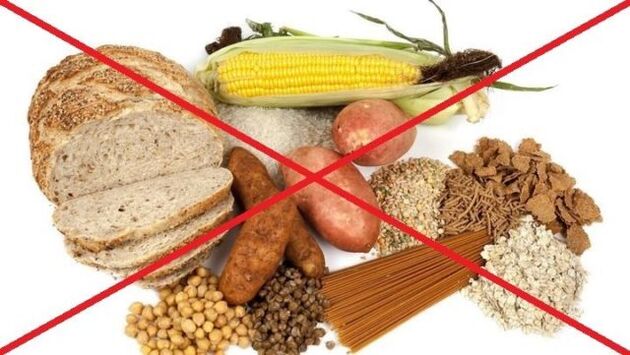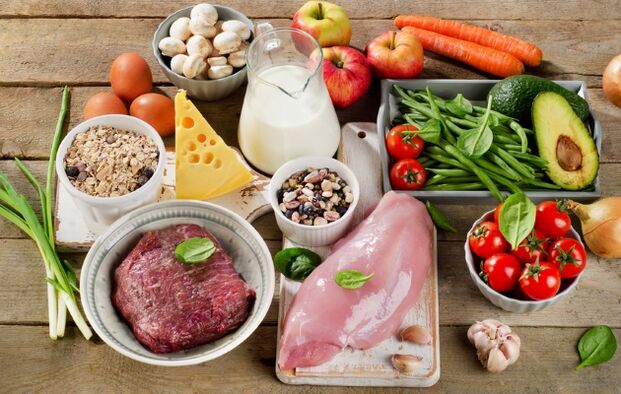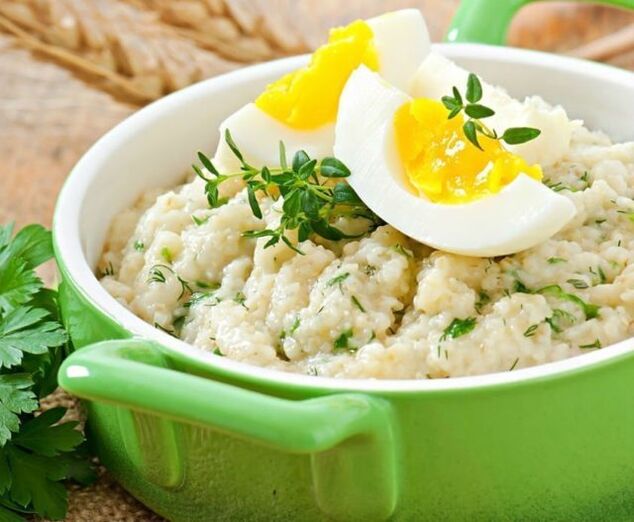
Inadequate nutrition, combined with poor nutrient absorption, leads to the progression of gout. This disease develops when the degree of uric acid in the blood exceeds the allowed limits (for men above 420 μmol / l, for women - 350 μmol / l). Disorder of metabolic processes leads to the fact that salts of this acid are deposited on the walls of the intestines, blood vessels, on joint surfaces and damage important organs of human life.
Over time, the disease becomes chronic with frequent relapses. In the acute period, patients experience excruciating pain at the site of localization of the pathological process. A diet for gout helps normalize uric acid levels and reduces the incidence of relapses.
Why diet for gout?
An important task of therapeutic measures is to reduce the nature and frequency of the manifestations of the disease. This can be achieved by reducing the uric acid content in the body.
The development of gout attacks is caused by:
- consuming large amounts of foods high in purines;
- metabolic disorder.
Optimizing the diet allows you to start the correct processes of assimilation and excretion of substances. Therapeutic measures aimed at eliminating the causes of the development of the disease are closely related to compliance with the restrictions of some food addictions. With the help of a properly prepared dietary menu, you can slow down the progression of the disease.

The foods that make up a person's daily diet should include foods that have a large amount of beneficial substances for the body.
Nutritional therapy for gout aims to reduce symptomatic manifestations by eliminating the food components that cause them. The products that a person eats every day have a tremendous effect on the state of health in general, it is responsible for the chemical processes that occur in the human body throughout his life.
What should not be eaten with gout?
On the basis of studies, scientists have identified a list of products that directly provoke the primary development of the disease and its subsequent progression.
The list of what not to eat for gout includes:
- spicy smoked cheese and cheese product;
- cholesterol-rich meat and bone products (pulp of young animals and pigs, hooves, buldyzhki);
- meat and bone fats, ears;
- high-fat fish (sardines, sprats);
- pickled vegetables, pickled fruits (cabbage, watermelons, cucumbers, apples);
- hot and cold smoked products;
- legumes (peas, beans, soybeans, lentils);
- vegetables, which contain oxalic acid (spinach leaves, sorrel, rhubarb root);
- hot spices, sauces;
- some varieties of vegetable crops (Brussels sprouts and cauliflower, radish);
- internal organs of animals obtained during carcass slaughter (kidneys, liver, lungs, heart, brain);
- oat grains;
- products using confectionery fat;
- alcohol of any percentage;
- fruits and berries (grapes, raspberries, figs);
- hot, pungent and ethereal spices (bay leaves, horseradish, chili pepper);
- fatty and oleaginous products of animal origin (butter, margarine, lard);
- canned meat, fish and vegetable products.

If the diet is not balanced or contains a large amount of fatty, spicy or heavy foods for the digestive system, then a person's metabolism may be disturbed.
The list of products, the use of which is recommended to be limited:
- coffee, strong tea;
- butter;
- plums
- nightshade vegetables (aubergines, tomatoes, peppers);
- table salt, granulated sugar;
- fungi (exclusively at the time of remission).
To alleviate an attack, as well as to maintain a state of remission, it is important to eliminate the above foods from the diet for an extended period.
What can you eat with gout?
List of foods recommended for use by patients with this disease:
- dietary meat products (rabbit, poultry, lean beef);
- lean white fish (pike, walleye, cod, pollock);
- bran and rye bread;
- chicken eggs (excluding the yolk);
- cereal dishes (rice, wheat, buckwheat, millet, pearl barley);
- fresh vegetables (beets, carrots, cucumbers, cabbage, potatoes);
- seasonal fruits, berries (watermelon, melon, apricots, strawberries, peaches, cherries, blackberries, green apples);
- pasta;
- walnut kernels (hazelnut, walnuts, cedar);
- herbal teas and decoctions (Dubrovnik, basil, catnip);
- fermented dairy products, cottage cheese;
- freshly squeezed juices, fruit drinks, compotes;
- cooked tomatoes;
- spices (turmeric, fennel, basil);
- vegetable oil (olive, rapeseed).

Nutritional therapy for gout will help the patient to quickly get rid of unpleasant and painful symptoms at home.
In limited quantities, natural honey is helpful for gout. This product is suitable as a substitute for sugar.
Honey has many beneficial properties:
- immunostimulant;
- antioxidant
- improve metabolic processes;
- bactericide.
During the acute period, you should not abuse this beekeeping product. Patients with this disease need to eat foods rich in vitamins, trace elements, amino acids. A helpful supplement is pharmaceutical fish oil for gout.
General feeding rules
Eliminating certain forbidden foods from your regular menu does not guarantee instant relief. Also, the list of products varies, depending on the stage and severity of the course of the disease. Therefore, nutrition for gout during an exacerbation implies compliance with stricter restrictions than during remission.

There is a common set of rules for patients with this ailment, the observance of which is important in diet therapy:
- Eat food in small portions several times a day at short intervals (5-6 times). Hunger causes an increase in acetone in the urine. And this can aggravate the course of the disease.
- Chew your food well, do not overeat.
- Limit the amount of table salt used in preparing dishes (up to 5 grams per day). Salt has the property of retaining fluid in the tissues, which, in turn, leads to the deposition of uric acid salts.
- Optimizes the balance of body fluids. For this, it is recommended to drink it at least 2 liters per day.
- Organize fast days. Preferably vegetables, dairy and fruits (except for those prohibited for consumption).
- Observe the restrictions for a long time, since the short-term use of a therapeutic diet is ineffective.
People who suffer from severe metabolic disorders and have a history of diabetes and gout should exclude dishes that cause jumps in blood uric acid and insulin levels. The diet for gout and diabetes is designed to reduce these indicators, in order to avoid the development of exacerbations and complications.
How to prepare food correctly?
The shopping list restriction is not the only element to observe. It is important to choose the correct cooking method when preparing your meals.

There are no special requirements for the preparation of products, with the exception of meat processing.
Cooking is allowed in the following ways:
- for a couple;
- baking;
- extinction
- boiling;
- languor.
Cooking is contraindicated by:
- frying;
- of smoking;
- salting and pickling;
- fermentation.
Do not use stale or burnt food. The temperature regime of the food consumed should be optimal for the food and not exceed the temperature of 40 degrees Celsius. Food should not be harsh and hard. If necessary, individual dishes can be chopped with a blender.
Effective diet: menu for every day
Medical nutrition in terms of the content of important components (balance of proteins, carbohydrates and fats), calories, vitamins, microelements, amino acids should correspond to the physiological needs of patients.

Approximate diet for gout and high uric acid:
1 day
First breakfast: boiled cod, mashed potatoes, black bread, white coleslaw, seasoned with sour cream, a cup of weak coffee with saccharin.
Second breakfast: cottage cheese casserole, boiled egg, bran bread, tea drink.
For lunch: vegetarian soup with roots and chips, beef stew, buckwheat porridge, fresh cucumber, 1 apple.
Dinner: carrot cutlets, pasta, milk, biscuits.
In the evening: 200 ml of kefir.
2nd day
First breakfast: stewed white cabbage, 1 boiled egg, black bread, cappuccino.
Second breakfast: cappuccino, sponge cake.
For lunch: lean borscht, bran bread, baked poultry steak, boiled rice, fruit jelly.
For dinner: stewed potatoes with vegetables, vegetable casserole, buttered bran bread, a glass of broth.
At night: 250 ml of curdled milk.

Day 3
First breakfast: vegetable salad (white cabbage, carrot, apple), soft coffee.
Second breakfast: cottage cheese with sour cream, rosehip broth.
For lunch: barley soup with sour cream, steamed cutlet, mashed potatoes, red berry jam, whole wheat bread.
For dinner: carrot cutlets with fruit, semolina casserole, a glass of milk.
Before bedtime: steamed prunes.
4th day
First breakfast: grated carrots with sour cream, wheat porridge, a glass of green tea.
Second breakfast: chops of nuts, compote, sponge cake.
For lunch: noodles with milk, boiled chicken with pumpkin and baked potatoes, fruit jelly, black bread.
For dinner: baked cheesecakes, carrot and apple cutlets, a glass of lemon tea.
At night: 200 ml of warm milk.
Day 5
First breakfast: oatmeal cooked in buckwheat milk, green tea.
Second breakfast: a glass of fresh carrot.
For lunch: rice soup with vegetables with sour cream, boiled beef pulp, beet caviar, basil infusion with honey, black bread.
For dinner: pumpkin casserole with sour cream, a glass of mild tea, crackers.
Before going to bed: rosehip with honey.
6 days
First breakfast: chicken protein omelette, stewed beets, white bread, a glass of soft coffee.
Second breakfast: zucchini casserole, fruit and berry compote.
Lunch: vegetarian barley soup, boiled potatoes, stewed meatballs, jelly, black bread.
Dinner: rice boiled in milk, soft tea.
Before going to bed: a glass of yogurt.
The standard nutritional regimen is developed by a physician. The dietary meal combination options allowed are varied. Diet number 6 is common for gout. Its main principle is the exclusion of foods and dishes with a high purine component, the addition of alkaline beverages to the diet, and gentle processing during cooking. An independently compiled menu with a restriction on the amount and nature of food can lead to a prolonged course of the disease.













































































